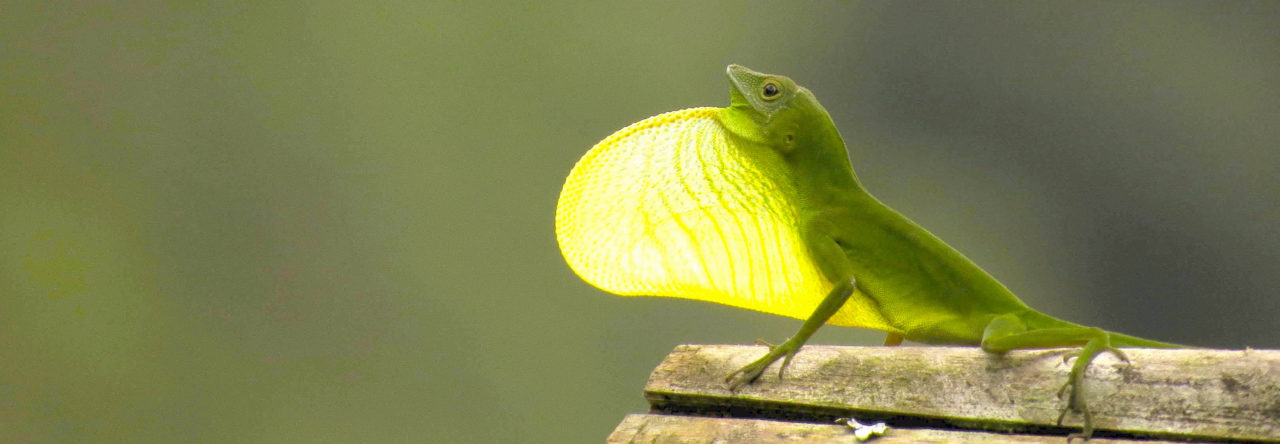
Anolis morazani. Photo by Josiah Townsend from iNaturalist.
The Anolis crassulus subgroup contains ten morphologically-conserved highland anole species found throughout Nuclear Central America. Its members have long been a source of headache for region’s systematists. To quote Meyer & Wilson (1971): “…specimens of the crassulus group from Guatemala and Mexico have a bewildering array of admixtures of the distinctive characters observed in Honduras… The inter-relationships of the populations… [of the crassulus group] are exceedingly complex, and… we are unable to suggest a satisfactory arrangement.” This was followed up 21 years later by McCranie, Wilson, & Williams (1992): “Clearly, a thorough analysis of crassulus-like specimens from throughout their range… is sorely needed”, and repeated by McCranie & Köhler (2015) 13 years after that.
Despite the need for a thorough investigation into this group, our understanding of the relationships and validity of these taxa has not improved much. This is partly because this subgroup has been poorly represented without broad sampling in larger-scale molecular phylogenies. Two samples in particular, an A. crassulus (from Chiapas, Mexico) and an A. sminthus (from Olancho, Honduras), have been continuously utilized, without additional samples from these species. Most recently, Nicholson et al. (2017; six species) and Poe et al. (2017; three) expanded the molecular sampling for this group, using single exemplars as part of broader analyses.
In a study published last month in BMC Evolutionary Biology, Josiah Townsend and I examined the evolutionary relationships of the majority of this subgroup, in order to provide a starting point for resolving some of the confusion surrounding these taxa.

Fig. 4 from Hofmann & Townsend, 2017: Species tree of the Anolis crassulus subgroup. Black nodes indicate PP > 0.95; PP < 50 not shown. Inset photo: Anolis heteropholidotus (2) by JHT.
The results of our multilocus phylogenetic investigation gave us some interesting new insights into the subgroup. We found support for the monophyly of the A. crassulus subgroup relative to other Anolis (as opposed to its paraphyly, as recovered in Poe et al. 2017), and the validity of all of its species (excepting the two we could not sample). Additionally, we recovered considerable overlooked diversity within this subgroup. Anolis crassulus itself represents at least four lineages corresponding to distribution: the Chortis Highlands of Honduras, the Salvadoran Cordillera, Guatemala, and Chiapas, Mexico. Surprisingly, the sample from Chiapas previously used in many phylogenies was recovered as an undescribed lineage sister to A. anisolepis, not conspecific with any of the four A. crassulus lineages, including another Chiapan lineage. We also recovered the widely-used “A. sminthus” sample (which was previously hypothesized by McCranie and Kohler (2015) as representing an undescribed lineage more closely related to A. crassulus) as an undescribed lineage sister to A. morazani, and found additional mitochondrial lineages within A. heteropholidotus and A. rubribarbaris. Diversification within the group was estimated to have started in the early Miocene in the Chortis Highlands (supporting the results of Nicholson et al. 2017), with the Honduran population of A. crassulus diverging from the other three lineages approximately 13 MYA.

Fig. 5 from Hofmann & Townsend, 2017: Chronogram showing results from divergence dating and ancestral area reconstruction analyses. PP shown when < 1.
Given the relatively deep divergence times within this group when compared with the apparent lack ecological and morphological diversification, we hypothesized that this subgroup represents a non-adaptive radiation, though extensive study is necessary to determine if these traits are as conserved as they appear. A taxonomic revision of the Chortis Highland population of Anolis crassulus is being finalized, but a great deal of work remains in order to improve our understanding of these highland anoles.
- Origins and Biogeography of the Anolis crassulus Subgroup - January 17, 2018


Erich Hofmann
The photo at the top is actually an Anolis morazani (described in Townsend & Wilson, 2009), one of the morphologically-similar anoles in the A. crassulus subgroup.
Levi Gray
Hi! Glad to see more work on the group. Do you have a locality for the Genbank sequence from Chiapas? I’m mostly curious whether it came from Tacana/Sierra Madre del Sur or from the Northern Highlands (where the type locality for anisolepis is).
Levi Gray
Saw that the locality is in the paper–Tacana (or around there). It’s a little worrying that relationships are fairly unresolved in both major groups within the crassulus group; crassulus + anisolepis and the many lineages described from Honduras are not well-supported.
I look forward to more work on the group! At the moment, the taxonomy is a reflection of the work by herpetologists working primarily in Honduras. More work in Guatemala and Chiapas is needed to tease apart what is going on in the anisolepis-crassulus cluster, and hopefully followup work on the lineages in Honduras/El Salvador/Nicaragua will help resolve the relationships within the rest.
I’ll also add that I have never seen a more confusing group in terms of within-population variation than crassulus in Chiapas and Guatemala. The variation you get from a single site is like no other species I’ve ever encountered. One could easily assume there are multiple species just going off morphology, especially if only a few specimens were looked at.